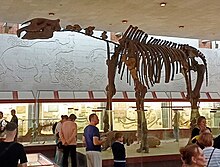Rhinocerotoidea: Difference between revisions
No edit summary Tag: Reverted |
No edit summary |
||
| (34 intermediate revisions by 21 users not shown) | |||
| Line 1: | Line 1: | ||
{{Short description|Superfamily of mammals}} |
{{Short description|Superfamily of mammals}} |
||
{{Hatnote|For the common rhinocerotoid family, see [[Rhinoceros]]}} |
|||
{{Automatic taxobox |
{{Automatic taxobox |
||
| name = |
| name = Rhinocerotoids |
||
| fossil_range = {{Fossil range|56|0|earliest=63}}[[Paleocene|Latest Paleocene]]-[[Holocene|Present]] |
| fossil_range = {{Fossil range|56|0|earliest=63}}[[Paleocene|Latest Paleocene]]-[[Holocene|Present]] |
||
| image = |
| image = Rhino collage.png |
||
| image_caption = |
| image_caption = Rhinoceroses, a type of rhinocerotoid |
||
| image2 = Палеонтологический музей Орлова (20221008151051).jpg |
|||
| image2_caption = Skeleton of ''[[Paraceratherium]]'' ([[Paraceratheriidae]]) |
|||
| taxon = Rhinocerotoidea |
| taxon = Rhinocerotoidea |
||
| authority = [[John Edward Gray|Gray]], 1821 |
| authority = [[John Edward Gray|Gray]], 1821 |
||
| subdivision_ranks = |
| subdivision_ranks = |
||
| subdivision = |
| subdivision = *{{extinct}}[[Hyracodontidae]] |
||
*{{extinct}}[[Amynodontidae]] |
|||
*{{extinct}}[[Paraceratheriidae]] |
|||
*{{extinct}}[[Eggysodontidae]] |
|||
*[[Rhinocerotidae]] |
|||
}} |
}} |
||
''' |
'''Rhinocerotoidea''' is a [[superfamily (taxonomy)|superfamily]] of [[Perissodactyla|perissodactyls]] that appeared 56 million years ago in the [[Paleocene]]. They included four extinct families, the [[Amynodontidae]], the [[Hyracodontidae]], the [[Paraceratheriidae]], and the [[Eggysodontidae]]. The only extant family is the [[Rhinocerotidae]] (true rhinoceroses), which survives as five living species. Extinct non-rhinocerotid members of the group are sometimes considered rhinoceroses in a broad sense. Although the term 'rhinoceroses' is sometimes used to refer to all of these, a less ambiguous vernacular term for this group is 'rhinocerotoids'. The family Paraceratheriidae contains the largest land mammals known to have ever existed.<ref name="Nature">{{cite journal |last1=Deng |first1=T. |last2=Lu |first2=X. |last3=Wang |first3=S. |last4=Flynn |first4=L. J. |last5=Sun |first5=D. |last6=He |first6=W. |last7=Chen |first7=S. |date=2021 |title=An Oligocene giant rhino provides insights into ''Paraceratherium'' evolution |journal=Communications Biology |volume=4 |issue=1 |pages=639 |doi=10.1038/s42003-021-02170-6 |pmc=8211792 |pmid=34140631}}</ref> |
||
==Taxonomy== |
==Taxonomy== |
||
The [[cladogram]] below follows a [[phylogenetic analysis]] by Bai ''et al.'' (2020):<ref name="Bai2020">{{cite journal |last1=Bai |first1=B. |last2=Meng |first2=J. |last3=Zhang |first3=C. |last4=Gong |first4=Y.-X. |last5=Wang |first5=Y.-Q. |title=The origin of Rhinocerotoidea and phylogeny of Ceratomorpha (Mammalia, Perissodactyla) |journal=Communications Biology |date=2020 |volume=3 |issue=1 |pages=509 |doi=10.1038/s42003-020-01205-8|doi-access=free }}</ref> |
The [[cladogram]] below follows a [[phylogenetic analysis]] by Bai ''et al.'' (2020):<ref name="Bai2020">{{cite journal |last1=Bai |first1=B. |last2=Meng |first2=J. |last3=Zhang |first3=C. |last4=Gong |first4=Y.-X. |last5=Wang |first5=Y.-Q. |title=The origin of Rhinocerotoidea and phylogeny of Ceratomorpha (Mammalia, Perissodactyla) |journal=Communications Biology |date=2020 |volume=3 |issue=1 |pages=509 |doi=10.1038/s42003-020-01205-8|doi-access=free |pmid=32929169 |pmc=7490376 }}</ref> |
||
{{Clade|style=font-size:85%; line-height:85% |
{{Clade|style=font-size:85%; line-height:85% |
||
| Line 110: | Line 117: | ||
{{Reflist}} |
{{Reflist}} |
||
{{Perissodactyla Genera|R.}} |
|||
{{Taxonbar|from=Q15487229}} |
{{Taxonbar|from=Q15487229}} |
||
{{Authority control}} |
|||
[[Category: |
[[Category:Rhinocerotoidea| ]] |
||
[[Category:Ceratomorpha]] |
|||
[[Category:Mammal superfamilies]] |
[[Category:Mammal superfamilies]] |
||
[[Category:Taxa named by John Edward Gray]] |
[[Category:Taxa named by John Edward Gray]] |
||
Latest revision as of 16:58, 22 October 2024
| Rhinocerotoids Temporal range: Latest Paleocene-Present
| |
|---|---|

| |
| Rhinoceroses, a type of rhinocerotoid | |

| |
| Skeleton of Paraceratherium (Paraceratheriidae) | |
| Scientific classification | |
| Domain: | Eukaryota |
| Kingdom: | Animalia |
| Phylum: | Chordata |
| Class: | Mammalia |
| Order: | Perissodactyla |
| Suborder: | Ceratomorpha |
| Superfamily: | Rhinocerotoidea Gray, 1821 |
| Families | |
Rhinocerotoidea is a superfamily of perissodactyls that appeared 56 million years ago in the Paleocene. They included four extinct families, the Amynodontidae, the Hyracodontidae, the Paraceratheriidae, and the Eggysodontidae. The only extant family is the Rhinocerotidae (true rhinoceroses), which survives as five living species. Extinct non-rhinocerotid members of the group are sometimes considered rhinoceroses in a broad sense. Although the term 'rhinoceroses' is sometimes used to refer to all of these, a less ambiguous vernacular term for this group is 'rhinocerotoids'. The family Paraceratheriidae contains the largest land mammals known to have ever existed.[1]
Taxonomy
[edit]The cladogram below follows a phylogenetic analysis by Bai et al. (2020):[2]
| Rhinocerotoidea |
| ||||||||||||||||||||||||||||||||||||||||||||||||
| (sensu lato) |
References
[edit]- ^ Deng, T.; Lu, X.; Wang, S.; Flynn, L. J.; Sun, D.; He, W.; Chen, S. (2021). "An Oligocene giant rhino provides insights into Paraceratherium evolution". Communications Biology. 4 (1): 639. doi:10.1038/s42003-021-02170-6. PMC 8211792. PMID 34140631.
- ^ Bai, B.; Meng, J.; Zhang, C.; Gong, Y.-X.; Wang, Y.-Q. (2020). "The origin of Rhinocerotoidea and phylogeny of Ceratomorpha (Mammalia, Perissodactyla)". Communications Biology. 3 (1): 509. doi:10.1038/s42003-020-01205-8. PMC 7490376. PMID 32929169.









